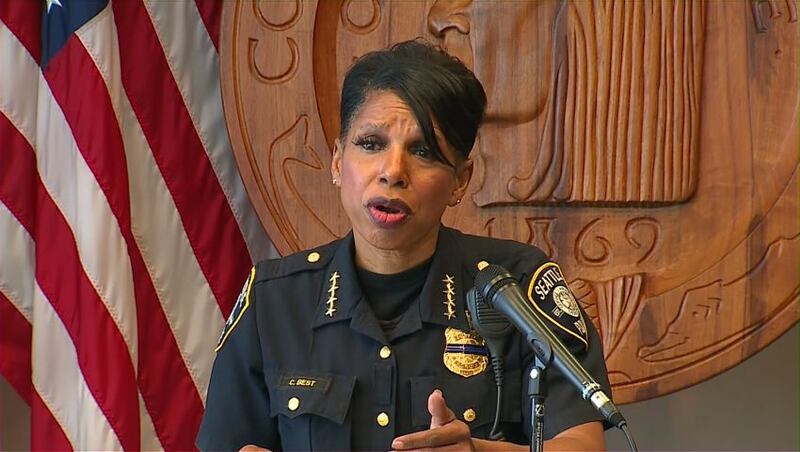SEATTLE — Thursday marked the seventh day of protests in Seattle. It comes after the largest protest Wednesday, which for the first time was entirely peaceful, and continued into the early morning hours.
Seattle Mayor Jenny Durkan and Police Chief Carmen Best announced in a press conference Thursday five changes that have already happened or are being worked on, in direct response to the people marching in the streets.
1) Visible badges
Chief Best announced changes to the mourning badge policy. She ordered officers not to cover their badge numbers with the mourning black tape used as a symbol of respect to fallen officers but to move them to allow for visibility. She said sergeants would get new badges that display numbers.
“We’ve heard people, we understand, we want to make sure we’re being transparent. That people don’t have the belief we’re trying in any way to hide who we are,” Best said.
2) No more curfew
The city officially lifted the curfew Wednesday night, saying how speaking with community leaders helped them realize it looked like the state was silencing voices.
“We want them to know they can come out, stay as long as they want to,” Best said Tuesday night, after talking directly with protestors at 11th and East Pine.
3) Keeping federal consent decree
The City Attorney’s Office also dropped the effort to lift federal oversight of the Seattle Police Department after hearing the community say SPD isn’t ready.
“We will continue to have the same kind of scrutiny as we look for additional ways to increase transparency and accountability,” Durkan said.
There were two more items mentioned in the press conference Durkan and Best said they are actively working on.
4) Body cameras and protests
Durkan addressed many of the protestors’ requests to have SPD body cameras turned on to record the protests.
“I believe we can and should change this policy,” Durkan said. She said the rule was put into place by city council to make sure the state cannot surveil people, but that she plans to meet with community leaders and city council on Friday to discuss re-examining the law.
“SPD is ready to turn those cameras on as soon as the work is done,” Durkan said.
5) Crowd dispersal using force
One common demand from protesters is for Seattle police to stop using measures like flashbangs and tear gas, among other tools.
On Friday, all three of Seattle’s police oversight agencies — the Community Police Commission, Office of Police Accountability, and Office of Inspector General — jointly recommended that the Seattle Police Department stop using CS gas, commonly known as tear gas.
The mayor said she is asking the inspector general to review the city’s policies of crowd management, set in 2017, which allows police to use those measures.
“The use of force in demonstrations as well as how the accountability systems must always be scrutinized. We must make sure the public has trust in it,” Durkan said.
People protesting Thursday said they want more — like what officers will do differently when someone is being arrested — but they are hopeful the movement is making a difference.
“I think we’re getting there. When we have this many people with a common goal and vision, and this much passion, I’m definitely optimistic about it,” said Taylor Cassell, a protestor at Cal Anderson Park on Thursday.
Durkan said there are no plans to defund SPD by 50%, as some protestors demanded on Wednesday, but acknowledged there is much more work to do.
“Just because we’ve made real gains, it does not mean we are finished,” Durkan said.
Best also said they have implemented more de-escalation techniques when responding to protestors, like standing farther back from the barrier and crowd. She said upon suggestions from a protestor and citizen journalist, they plan to bring loudspeakers to big gatherings to better communicate with crowds.
More news from KIRO 7
- Coronavirus: Pierce, Snohomish counties submit applications to move into phase 2
- ‘Can’t breathe:’ Tacoma police restraint of Manuel Ellis caused his death, ME reports
- Retired police captain killed on Facebook Live while protecting friend’s pawn shop
- Do you have an investigative story tip? Send us an email at investigate@kiro7.com
© 2020 Cox Media Group








